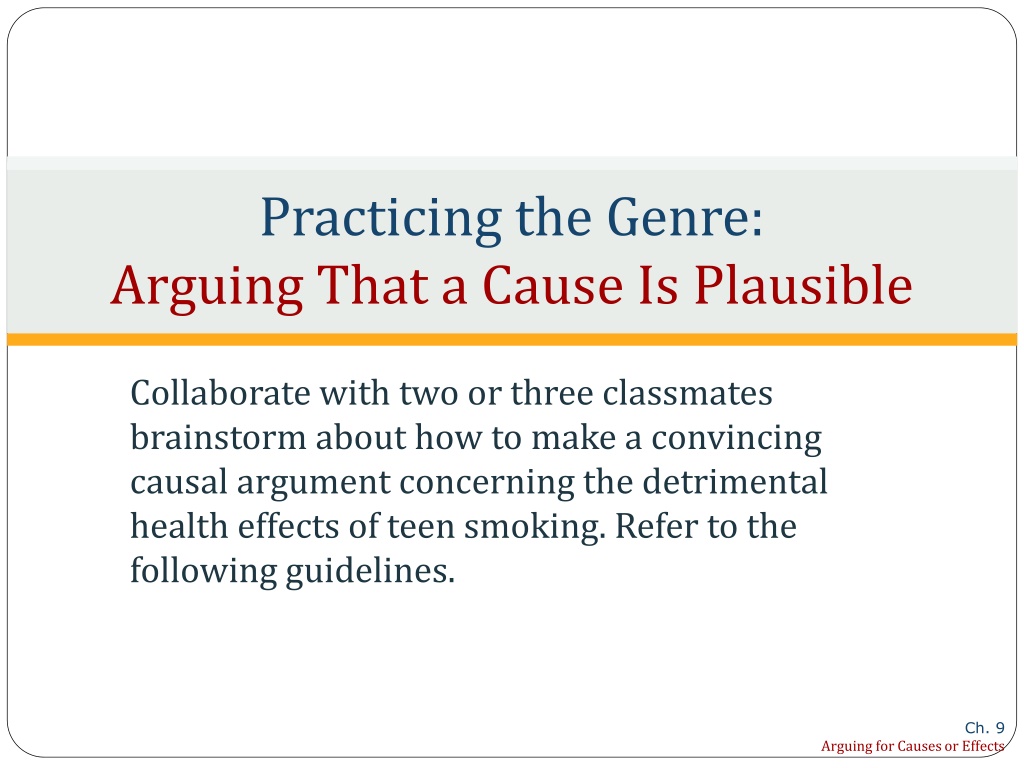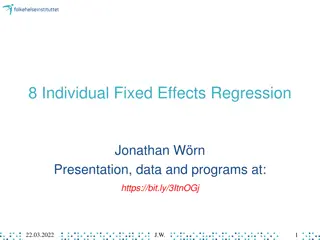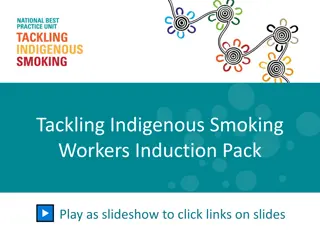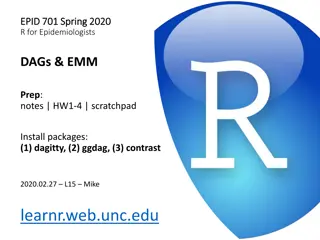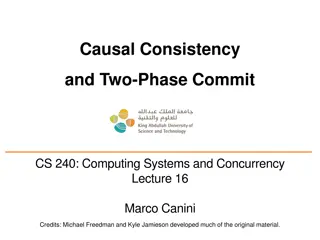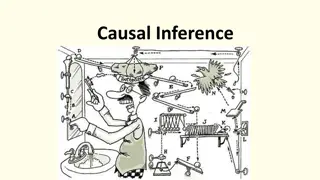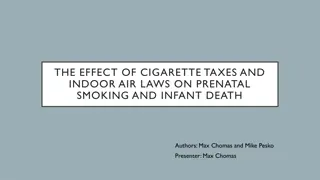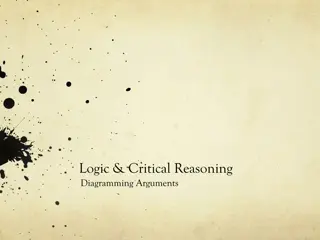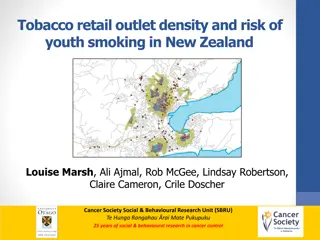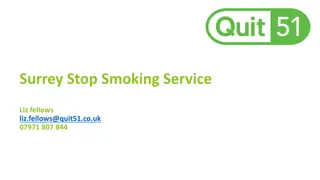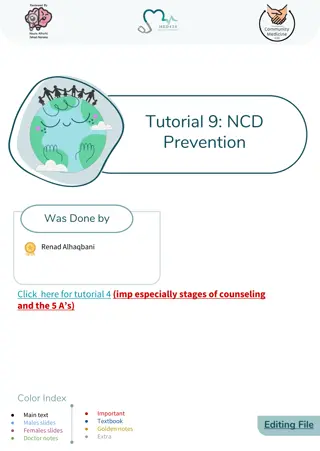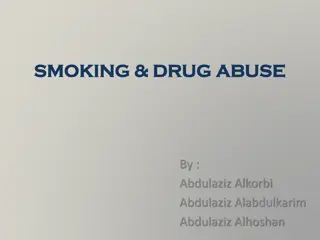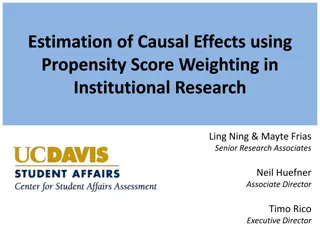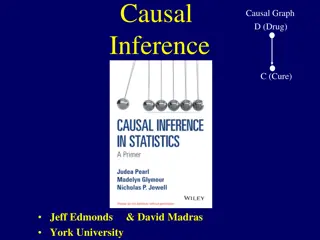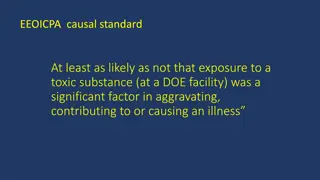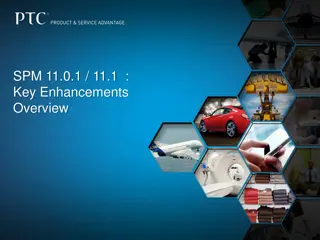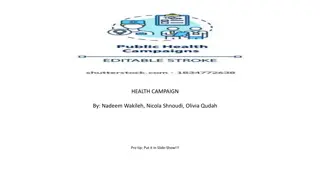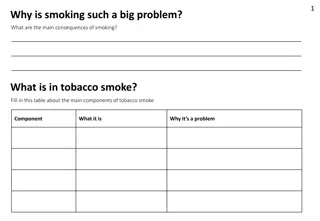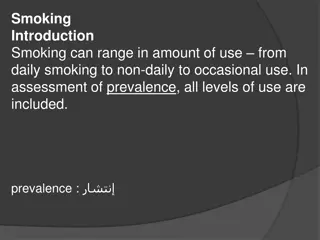Making a Convincing Causal Argument on Teen Smoking Effects
In collaboration with classmates, brainstorm about addressing various audiences regarding the detrimental health effects of teen smoking. Explore potential causes, gather supporting evidence, and consider audience engagement to craft a persuasive argument. Analyze existing causal arguments presented by different authors to enhance your own approach.
Download Presentation

Please find below an Image/Link to download the presentation.
The content on the website is provided AS IS for your information and personal use only. It may not be sold, licensed, or shared on other websites without obtaining consent from the author. Download presentation by click this link. If you encounter any issues during the download, it is possible that the publisher has removed the file from their server.
E N D
Presentation Transcript
Practicing the Genre: Arguing That a Cause Is Plausible Collaborate with two or three classmates brainstorm about how to make a convincing causal argument concerning the detrimental health effects of teen smoking. Refer to the following guidelines. Ch. 9 Arguing for Causes or Effects
Part One Choose your audience and purpose: Are you addressing other college students, faculty, administrators, the general public, or teens themselves? Is your goal to change opinions or behavior, or to inspire the creation of useful school policies? Brainstorm a list of causes that could explain why some high school students choose to smoke. Finally, pick your most plausible cause and discuss these questions: What evidence would you need to support an argument for your preferred cause? Where could you find the supporting evidence you need?
Part Two Discuss what you learned: How did your group initially come up with possible causes? Did you recall your own experiences and observations? Did you consider different categories of causes, such as cultural, biological, psychological, or social? What did you assume about your audience? Did you think audience members would already be interested in your argument or perhaps that they would resent being the focus of this kind of inquiry? What kinds of supporting evidence did you think your audience would find persuasive?
Guide to Reading: Analyzing Causal Arguments Read the selections in this chapter and analyze how writers make provocative causal arguments: Clayton Pangelinan argues that the popularity of social media is driven, not only by our need to connect, but also by our curiosity and our narcissism (pp. 391-95). Stephen King offers causes for why we crave horror movies beyond the simple shiver effect (pp. 396-98). Claudia Wallis argues that multitasking is not the wonderful way to achieve more productivity that many people think it is (pp. 401-7). Shankar Vedantam tries to explain why people are often generous toward individuals or small groups but do not help large groups (pp. 409-13).
Analyzing Causal Arguments: Determine the writer s purpose. What seems to be the writer s main purpose? to engage readers in thinking about the subject in creative new ways? to convince readers to contemplate causes or effects that have not been considered or taken seriously before? to persuade readers that surprising causes or effects are likely to play a significant role?
Analyzing Causal Arguments: Determine the writer s audience. What does the writer assume about the audience? that readers know little about the subject and need to be inspired to care? that they know little about the subject but are likely to be curious about it? that they know a lot about the subject and are likely to have their own ideas about causes or effects? that they know a lot about the subject but are open to new ideas?
Analyzing Causal Arguments: Assess the genre s basic features. A Well-Presented Subject A Well-Supported Causal Analysis An Effective Response to Objections and Alternative Causes or Effects A Clear, Logical Organization
A Well-Presented Subject Look first at the title and opening paragraphs to see what the subject is and whether it is clearly and vividly established. Cite statistics or provide illustrations to establish the subject. Begin with a compelling anecdote to arouse readers curiosity. Pose why questions to stimulate your audience.
A Well-Supported Causal Analysis Find where the writer identifies and discusses each possible cause or effect, and note which one(s) the writer favors as being the most plausible as well as the most interesting. Assess the persuasiveness of the supporting evidence, which may be quotations from experts or references to research studies. Check that the cause-effect argument makes sense. Keep an eye out for these logical fallacies, or any other errors: Mistaking chronology for causation: Assuming that because one thing preceded another, the former caused the latter (also called by its Latin name, post hoc, ergo propter hoc, meaning after this, therefore because of this ). Mistaking correlation for causation: Assuming that because two things seem to be related or complementary that one thing caused the other (sometimes called with this, therefore because of this ).
An Effective Response to Objections and Alternative Causes or Effects Notice where the author anticipates and responds to objections and alternative causes or effects. Writers often present the most familiar causes/effects first, and then delve into more detailed consideration of the writer s preferred cause/effect. Sentence strategies to look for: Most people assume X; however, _______. X and Y are the usual suspects, but let s look at a totally new possibility: _______.
A Clear, Logical Organization Read to see if the writer provides cues to help readers follow the logic of the causal argument. Examine the writer s thesis statement for the preferred cause/effect. Look also for a forecasting statement, which identifies the main causes, effects, key supporting topics, or examples, in the order they are discussed within the essay. Writers may cue readers by repeating terms from forecasting statements in the essay s topic sentence. Other cues include: a thesis statement and possibly a forecast of the main cause(s) topic sentences announcing each new cause/example clear transitional words and phrases visuals (charts, graphs, tables, etc.) headings that break selections up according to topic/cause
Guide to Writing: The Writing Assignment Choose a subject to write about and speculate about its possible causes and effects. In your essay, remember to demonstrate that the subject exists, to argue for the plausibility of certain causes/effects, and to anticipate readers likely objections.
Starting Points: Justifying an Evaluation Basic Feature Ask Yourself . . . Take a Look at . . . How do I come up with a subject to write about? Consider possible topics: Popular culture. (p. 401) Consider possible topics: Self-destructive behavior. (p. 409) Consider possible topics: Current events. (p. 416) Choose a subject to analyze. (pp. 420-21) Test Your Choice: Choosing a Topic (p. 421) How can I present my subject clearly and effectively? Determine the writer's purpose and audience. (p. 387) Assess the genre s basic features: A well-presented subject. (p. 388) A Well-Presented Subject: Reframing the Subject for Readers (p. 399) A Well-Presented Subject: Using Examples to Reframe the Subject (p. 407) A Well-Presented Subject: Using Anecdote to Dramatize the Subject (p. 414) Present the subject to your readers. (p. 422) A Troubleshooting Guide: A Well-Presented Subject (p. 433) A Well-Presented Subject
Starting Points: Justifying an Evaluation Basic Feature Ask Yourself . . . Take a Look at . . . How do I come up with a list of possible causes to explore? Analyze possible causes or effects (p.423) Conduct research. (p. 424) A Well-Supported Causal Analysis How can I convince my readers that the causes I identify are plausible? Assess the genre s basic features: A well-supported causal analysis (pp. 388-89) A Well-Supported Causal Analysis: Using Examples and Comparisons (p. 399) A Well-Supported Causal Analysis: Using a Variety of Sources (p. 408) A Well-Supported Causal Analysis: Using a Source (pp. 414-15) Analyze possible causes or effects. (p. 423) Conduct research. (p. 424) Cite a variety of sources to support your causal analysis. (p. 425) Formulate a working thesis stating your preferred cause(s) or effect(s). (pp. 425-26) A Well-Supported Causal Analysis
Starting Points: Justifying an Evaluation Basic Feature Ask Yourself . . . Take a Look at . . . How can I deal with my readers likely objections or alternative causes? Assess the genre s basic features: An effective response to objections and alternative causes or effects. (pp. 389- 90) An Effective Response: Putting Aside Obvious Causes or Effects (p. 400) An Effective Response: Presenting, Conceding, and Refuting Opposing Views (p. 408) An Effective Response: Using Counterexamples (p. 415) Draft a response to objections readers are likely to raise. (pp. 426-27) Draft a response to the causes your readers are likely to favor. (427-28) A Troubleshooting Guide: An Effective Response (p. 433) An Effective Response to Objections and Alternative Causes and Effects
Starting Points: Justifying an Evaluation Basic Feature Ask Yourself . . . Take a Look at . . . How can I help my readers follow my argument? Assess the genre s basic features: A clear, logical organization. (pp. 390-91) A Clear, Logical Organization: Using Cause-Effect Sentence Strategies (p. 400) A Clear, Logical Organization: Using Headings and other Strategies (p. 419) A Clear Logical Organization: Using Rhetorical Questions (pp. 415-16) Create an outline that will organize your causal analysis effectively for your readers (p. 429) A Troubleshooting Guide: A Clear, Logical Organization (p. 434) A Clear, Logical Organization
Guide to Writing: Writing a Draft: Invention, Research, Planning, and Composing The following activities will help you choose a subject for which you can compose a causal analysis. You can use your responses to the following activities in your rough draft.
Choose a subject to evaluate. The subject you choose must be: one that you can show exists (using examples or statistics); one that has no definitive, proven causes/effects; one that you can research, as necessary, in the time you have; one that will puzzle/interest you and your readers. You can choose subjects related to school, your community, or work.
Test Your Choice Choosing a Subject Make your choice and ask yourself the following questions: Do I know enough about the subject, or can I learn enough in the time I have? Do I know what causes or effects readers would be likely to think of, and do I have any ideas about what causes or effects might surprise and interest them? Get together with two or three students and take turns presenting your subject and listening to others descriptions.
Present the subject to your readers. Once you have chosen a subject, consider how to present it in a way that interests readers; what you think of your subject; what your readers are likely to think of it. Consider . . . Ask Yourself . . . WHAT DO I THINK? Why do I find this subject intriguing? I think X is important because ______ . X is changing the way we think/do ______. X has widespread effects, such as ______. I know what the obvious causes/effects of X are, but I m curious about the underlying cultural/psychological/ideological causes/effects because _________. WHAT DO MY READERS THINK? What will readers know about the subject? My readers will probably be familiar with X because _____. X is likely to be new to my readers, so I will need to show that it is widespread and serious by providing evidence such as ______. My readers are likely to be curious about X because ______.
Present the subject to your readers. Consider . . . Ask Yourself . . . WHAT DO I THINK? Which possible causes/effects will surprise readers or help them think about the subject in a constructive new way? I think X will enable readers to understand that ______. Thinking about X will challenge readers to _______. How do your subject and its causes/effects compare or contrast with other, more familiar subjects? X is like Y in that they are both caused by _____. Whereas Y is _______, X is ________. WHAT DO MY READERS THINK? How might readers age, gender, work, or cultural background affect their thinking? Readers who are/have trait A may assume that X is caused by individuals who should have ________. Readers who are/have trait B are likely to think the causes/effects are part of a larger system that involves _______. Readers who have experienced C may think of X in terms of ______. What causes or effects are readers likely to know about? My readers will have heard of X from ______ [name source]. Readers experience of D will lead them to assume that X was caused by ______ .
Analyze possible causes or effects. The following activity will help you analyze possible causes/effects. Causal analysis essays often speculate about several possibilities, but usually argue only for an especially interesting one. HOW CAN I ANALYZE POSSIBLE CAUSES OR EFFECTS? 1. List the possible causes or effects you ve identified so far ones that your readers are likely to think of, that your classmates suggested, that you found doing research, and that you thought of yourself. 2. Write a few sentences about each cause or effect, answering questions like these: Why do my readers think _________ could have caused X? Why do I think __________ could have caused X? Is __________ necessary to bring about X; that is, could X not happen without X? Is X sufficient enough in itself to cause _________?
Analyze possible causes or effects. HOW CAN I ANALYZE POSSIBLE CAUSES OR EFFECTS? CONT D If X is one of several contributing factors, what role does it play? For example, is it a minor or major cause, an obvious or hidden cause, a triggering cause (the one that got the cause-effect process started) or a contributing cause (the one that keeps it going)? What kinds of evidence could I use to argue in favor of or against X? (If you don t already have supporting evidence, make a Research To Do note indicating what kind of evidence you need and where you might possibly find it.) 3. Classify the causes or effects you plan to discuss in your essay into three categories: plausible cause(s)/effect(s) you want to argue for, causes/effects your readers may favor that you can CONCEDE but put aside as obvious or minor, and causes/effects you should REFUTE because your readers are likely to think they are important. Plausible cause(s)/effect(s) to argue for Readers causes/effects to concede/put aside Readers causes/effects to refute Remember that the only category you must include in your essay is the first: one of more causes or effects you will argue played a major, and perhaps surprising, role.
Conduct research. If you are analyzing a cause that someone has already written about, utilize databases such as: Academic OneFile (InfoTrac) or Academic Search Complete (EBSCOHost) for magazines and journals; Lexis/Nexis for newspaper articles; Google, for Web sites, blogs, podcasts, etc.; your library s catalog for relevant books; For graphical, numerical, or statistical evidence, consult the following Web sites: USA.gov Library of Congress page on State Government Information (loc.gov/rr/news/stategov/stategov. html) U.S. Census Bureau (census.gov) The Centers for Disease Control and Prevention (cdc.gov) National Center for Education Statistics (nces.gov) Pew Research Center (pewresearch.org) Gallup (gallup.com) or Rasmussen Reports (rasmussenreports.com)
Cite a variety of sources to support your causal analysis. Writers of causal analyses rely on expert evidence from a variety of sources to support and refute causes/effects. Whether or not a certain type or minimum number of sources is required, consider whether the sources you ve gathered are appropriate and sufficient. As you determine how many and what types of sources to cite, ask yourself these questions: Are my sources appropriate will my audience accept them as authoritative? Are my sources sufficient do I have enough sources and do they reflect a variety of areas of expertise? Do I paraphrase or summarize my sources accurately, without borrowing too much of the source s language or sentence structures? Do I use signal phrases to provide the credentials of my sources?
Formulate a working thesis stating your preferred cause(s) or effect(s). HOW CAN I ASSERT MY THESIS? To get an idea about how you might formulate your thesis, take a look at the thesis statements from the reading selections you ve studied in this chapter. The fact that social networking is popular is well established. The question is why is it so popular? A better answer is that social media offer people a way to satisfy their desire to connect with others and maybe also be world-famous for fifteen minutes (as Andy Warhol supposedly remarked). (Pangelinan, par. 2) The mythic horror movie, like the sick joke, has a dirty job to do. It deliberately appeals to all that is worst in us. It is morbidity unchained, our most base instincts let free, our nastiest fantasies realized and it happens, fittingly enough, in the dark. (King, par. 11) The mental habit of dividing one s attention into many small slices has significant implications for the way young people learn, reason, socialize, do creative work and understand the world. (Wallis, par. 13) I want to offer a disturbing idea, The reason human beings seem to care so little about mass suffering and death is precisely because the suffering is happening on a mass scale. The brain is simply not very good at grasping the implications of mass suffering. (Vedantam, par. 12)
Formulate a working thesis stating your preferred cause(s) or effect(s). HOW CAN I ASSERT MY THESIS? CONT D Now draft your own thesis statement, using the examples from the readings or the sentence strategies that follow as a jumping-off point. You can put your ideas into your own words now or when you revise: The reasons for X may surprise you, such as __________, ___________, and __________. The effects of X may be alarming, but they are clear: _____________. X plays a disturbing role in our lives/our families/our communities/our workplaces: it does/is/provides ___________. For many years, Group A has believed that ___________. Now there is much research supporting this claim, but not for the reasons you may think. It s not ________ that has been causing this phenomenon but ____________ .
Draft a response to objections readers are likely to raise. HOW CAN I RESPOND EFFECTIVELY TO MY READERS OBJECTIONS? 1. For each of your preferred causes or effects, consider the questions your readers might raise. Some possibilities include the following: Even if you can prove that X and Y increased/decreased at the same time, how do you know X actually caused Y? Even if you can prove that Y occurred after X, how do you know X actually caused Y? Could X and Y both have been caused by something else altogether? X seems to have been an effect of Y but was it really a major effect or just one of many insignificant results? 2. Use the following sentence strategies or language of your own to respond to one of these objections: The objection that Y may result from things other than X may be true. But there is strong evidence showing that X played a central role by ___________. Researchers studying ___________ have shown a causal connection between X and Y. They claim that ___________ [quote/paraphrase/summarize information from source] (cite source). A large number of people have been polled on this question, and it appears that X was an important factor in their decision to ____________.
Draft a response to the causes or effects your readers are likely to favor. HOW CAN I RESPOND TO MY READERS PREFERRED CAUSES OR EFFECTS? Choose an alternative cause or effect, and summarize it. Be sure to summarize it accurately and fairly. Do not commit the straw man fallacy of knocking down something that no one really takes seriously. Decide whether you can REFUTE the alternative cause of effect or whether you need to CONCEDE it. Refine the alternative cause or effect if you can show that it lacks credible support or if the underlying reasoning is flawed. Conceded it by pointing out that the cause or effect is obvious and setting it aside or by showing that it plays a less important role than the cause or effect you are championing. Try the following sentence strategies, or use language of your own.
Draft a response to the causes or effects your readers are likely to favor. HOW CAN I RESPOND TO MY READERS PREFERRED CAUSES OR EFFECTS? CONT D To Refute Lacks Credible Support Just because Y caused ____________ does not mean that it caused ____________ [a similar subject]. Here s why: ____________. The scenario/anecdote others sometimes use to explain why X caused/occurred certainly helps dramatize ____________, but it doesn t really explain why X happened. If X is the result of Y , then one would expect ____________ to happen, too, but it hasn t/the opposite has happened. Reasoning Is Flawed Mistakes correlation for causation. Some argue that Y caused X because X and Y occurred/began rising sharply at the same time. But, in fact, this is merely a coincidence/both were caused by something else altogether. Mistakes chronology for causation. Just because Y occurred before/after X doesn t prove that X caused/resulted from Y . Proponents of ____________ have not provided convincing evidence to show how Y could have caused X .
Draft a response to the causes or effects your readers are likely to favor. HOW CAN I RESPOND TO MY READERS PREFERRED CAUSES OR EFFECTS? CONT D To Concede Set Aside a Well-Known Cause An obvious explanation is ____________. But if we dig deeper, we find that ____________. Typical explanations include ____________ and ____________, but let s consider a totally different possibility: ____________. Show That an Alternative Cause Is Minor ____________ is one of the answers but may not play as central a role as most people think it does. ____________ may have kept the process going, but X was the trigger: Without it, Y would never have gotten started. ____________may have been a factor at the outset, getting the process started, but what keeps it going is X.
Create an outline that will organize your causal argument effectively for your readers. Make an outline of what you have written, including these four basic parts: 1. Presentation of the subject 2. Plausible causes/effects, logically sequenced 3. Convincing support for each cause or effect 4. A consideration of readers questions, objections, and alternative causes or effects The following slide describes two options for organizing these outline components.
Create an outline that will organize your causal argument effectively for your readers. If your readers are not likely to favor any alternatives, you may want to anticipate and respond to their possible objections to your causes or effects. If you expect readers are likely to favor alternatives, you may want to concede or refute them before offering your own cause or effect. Presentation of the subject: Demonstrate that the subject exists and that its causes/effects are uncertain Thesis and forecasting statement: Announce the causes/effects you will offer First cause/effect with supporting evidence and refutation of objection Second cause/effect with supporting evidence and refutation of objection (and so on) Conclusion: Reassertion of judgment Presentation of the subject: Demonstrate that the subject exists and that its causes/effects are uncertain Thesis statement: Acknowledge alternative causes/effects readers are likely to know about Concession of first alternative cause/effect to set it aside Refutation of second alternative cause/effect with supporting evidence Writer s preferred cause/effect with supporting evidence Refutation of objection(s) Conclusion: Reassertion of judgment based on shared criteria I. I. II. II. III. III. IV. IV. V. V. VI. VII.
Write the opening sentences. Use what you ve written so far to help you effectively present the subject of your causal argument: Demonstrate the relevance of your topic by putting it in context for your reader. Begin with a surprising assertion that would help grab your readers attention. Begin with a scenario or an anecdote.
Draft your evaluation. By this point, you have done a lot of writing to: devise a well-presented subject and analyze its causes/effects; support your preferred causes/effects with evidence your readers will find persuasive; refute or concede objections and alternative causes/effects; organize your ideas to make them clear, logical, and effective for readers. Tie together all of this material and create your draft.
Guide to Writing: Evaluating the Draft: Using Peer Review In a peer review session, exchange drafts with classmates and give each other a critical reading. A good critical reading will: 1. Let the writer know how well the reader understands the causal analysis. 2. Praise what works best. 3. Indicate where the draft could be improved and make suggestions on how to improve it.
A Peer Review Guide Basic Feature Ask Yourself . . . How effectively does the writer present the subject? Summarize/Praise/Critique Summarize: Tell the writer what you understand the subject to be and why he or she thinks it is important and worth analyzing. Praise: Give an example of something in the draft that you think will especially interest the intended readers and help them understand the subject. Critique: Tell the writer if you have any confusion or uncertainty about the subject. What further explanation, examples, or statistics do you need to understand it better? If you can think of a more interesting way to present the subject, share your ideas with the writer. A Well- Presented Subject
A Peer Review Guide Basic Feature Ask Yourself . . . How plausible are the proposed causes or effects, and how well does the writer support the causal analysis? Summarize/Praise/Critique Summary: Identify the possible causes or effects the writer argues are the most plausible and interesting. Praise: Tell the writer which cause or effect seems most convincing. Point to any support (such as a particular example, a statistic, a research study, or a graph) that you think is especially strong. Critique: Tell the writer if any of the causes or effects seem too obvious or minor, and if you think an important cause or effect has been left out. Where the support seems lacking or unconvincing, explain what is missing or seems wrong. If the reasoning seems flawed, what makes you think so? A Well- Supported Causal Analysis
A Peer Review Guide Basic Feature Ask Yourself . . . How effectively does the writer respond to readers objections and alternative causes or effects? Summarize/Praise/Critique Summary: Identify the objections or alternative causes or effects to which the writer responds. Praise: Point out any response you think is especially effective, and tell the writer what makes you think so. For example, indicate where the support is especially credible and convincing. Critique: Point to any objections or alternative causes or effects that the writer could have responded to more effectively, and suggest how the response could be improved. Also indicate if the writer has overlooked any serious objections. An Effective Response to Objections and Alternative Causes and Effects
A Peer Review Guide Basic Feature Ask Yourself . . . How clear and logical is the causal analysis? Summarize/Praise/Critique Summary: Underline the thesis statement and topic sentences. Praise: Give an example of where the essay succeeds in being especially clear and easy to follow for example, in its overall organization, its use of key terms and transitions, or its use of visuals. Critique: Point to any passages where the writing could be clearer, where topic sentences or transitions could be added, or where key terms could be repeated to make the essay easier to follow. Try suggesting a better beginning or a more effective ending. A Clear, Logical Organization
Guide to Writing: Improving the Draft: Revising, Editing, and Proofreading Reflect on what you have written thus far: Review critical reading comments from your classmates, instructor, or writing center tutor. What are your readers getting at? What else should you consider about your invention writing? Review your draft. What can you do to present your causal analysis more compellingly?
A Troubleshooting Guide Basic Feature Problem My readers don t understand the subject or see why it is important. Options Reconsider what your readers already know, and provide additional background if necessary. Try providing examples or an anecdote to interest readers in the subject. Quote authorities and explain research findings, including statistics, to demonstrate the subject s importance that it is widespread and significant. Use visuals graphs, tables, photographs, or screen shots to make the subject more vivid. Review your research to see if you can add anything to help clarify the subject for your readers, or do some additional research. Pose the subject directly or indirectly as a why question, and then answer it. A Well- Presented Subject
A Troubleshooting Guide Basic Feature Problem Options My readers don t understand which of the causes or effects I am arguing are the most plausible. Be explicit about which causes or effects are the ones you think are most plausible, and why you think so. Use a thesis and forecasting statement followed by topic sentences with key terms to announce your main causes or effects. My readers do not find my causal argument convincing. Whenever possible, explain how the cause-effect relationship works, backing up your explanation with appropriate support. Cite more credible experts, being sure to give their credentials. Cite research studies and statistics rather than limiting yourself to examples and anecdotes. Review your sources to make sure they are varied, or do additional focused research to fill in where your analysis is weak. Make sure your sources are cited properly. A Well- Supported Causal Analysis
A Troubleshooting Guide Basic Feature Problem My readers do not think my responses are effective. Options Respond directly to criticism of your reasoning by showing that you are not mistaking correlation or chronology for causation. Demonstrate that you understand the complexity of the cause-effect relationship you are analyzing, for example, by indicating how your cause relates to other contributing causes. If your readers think you have overlooked an objection, consider it seriously and do further research to respond to it if necessary. An Effective Response to Objections and Alternative Causes and Effects
A Troubleshooting Guide Basic Feature Problem My readers think my analysis is not clear or logical. Options If readers have difficulty finding the thesis statement or topic sentences, consider revising them. Add a forecasting statement early in the essay to help guide readers. Review your use of transitions, and consider adding transitions to make the logical relationships among sentences and paragraphs clear to readers. Refer to visuals explicitly (for example, by adding the direction, see fig. 1 ), and include a caption tying each visual to the text discussion. Outline your essay to review its structure, and move, add, or delete sections as necessary to strengthen coherence. A Clear, Logical Organization
Edit and proofread your draft. Checking Your Use of Numbers Checking for Reason Is Because Constructions Academic writing prescribes conventions for citing dates, percentages, fractions, and other numbers. Causal analysis essays often contain sentences constructed around a reason is because pattern: The Problem: Ignoring these conventions will confuse readers and make them question your attention to detail. The reason we lost the war is because troop morale was down. The Problem: Since because means for the reason that, such sentences say essentially that the reason is the reason. The Solution: Spell out numbers and fractions of one or two words; use numbers when they are more than two words; write percentages and dates with figures; and spell out numbers that begin a sentence. The Solution: Rewrite the sentence so that it uses either the reason is or because, but not both.
Thinking Critically Reflecting on What You Have Learned Reflect on what you have learned about constructing causal arguments. Consider what you learned from the chapter s readings, your own writing, and any input from class discussions and collaboration.
Analyze & Write Write a blog post, a letter to your instructor or a classmate, or an e-mail message to a student who will take this course next term, using the writing prompt that seems most productive for you: Explain how your purpose and audience influenced one of your decisions as a writer, such as how you explained the subject, how you supported your preferred causes or effects, or how you responded to readers likely objections. Discuss what you learned about yourself as a writer in the process of writing this argument or from remixing it in another genre or medium. For example, what part of the process did you find most challenging? Did you try anything new, like getting a critical reading of your draft or re-envisioning your essay as a proposal or a presentation?
Analyze & Write If you were to give advice to a friend who was about to write a causal argument, what would you say? Which of the readings in this chapter influenced your essay? Explain the influence, citing specific examples from your essay and the reading. If you got good advice from a critical reader, explain exactly how the person helped you perhaps by questioning your use of support, your choice of medium, your use of visuals, the way you began or ended your essay, or the kinds of sources you used.
Thinking Critically Reflecting on the Genre Causal arguments are always shaped by the writer s expertise and special interests. Stephen King, for example, has a personal interest in establishing the horror movie as a legitimate literary and cinematic form. Shankar Vedantam, a science journalist, is sympathetic to the works of evolutionary psychologists and philosophers that he quotes to support his claims.
